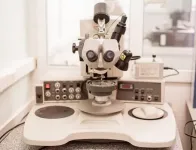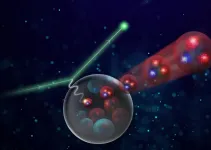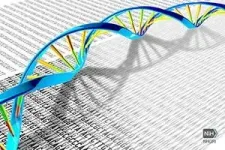INFORMATION:
Scientists investigated more thoroughly Walker breakdown in 3D magnetic nanowires
2021-02-25
(Press-News.org) Physicists from Russia, Chile, Brazil, Spain, and the UK, have studied how the magnetic properties change in 3D nanowires, promising materials for various magnetic applications, depending on the shape of their cross-section. Particularly, they more deeply probed into the Walker breakdown phenomenon, on the understanding of which the success of the implementation of the future electronics devices depends. The research outcome appears in Scientific Reports.
The cross-sectional geometry of a three-dimensional nanowire affects the domain wall dynamics and therefore is crucial for their control. In turn, managing the DW dynamics under various external conditions is necessary in order to realize the future electronics and computing devices, operating on new physical principles. Such equipment will be faster, more reliable, smaller, and more energy-efficient. An example of it is magnetic memory, generators of magnetic signals, magnetic logic devices.
The domain wall dynamics in magnetic nanowires is curbed by the Walker breakdown phenomenon. That is the loss of the linear dependence of the velocity of domain walls on the magnitude of the external magnetic field when the field exceeds a critical value known as the Walker field.
"We managed to find out that the oscillatory behavior of the DW in a nanowire with a polygonal cross-section comes from energy changes due to deformations of the DW shape during the rotation around the nanowire. Thus, a deeper understanding of the Walker breakdown phenomenon is provided," says research participant Yuri Ivanov, a docent at the Department of Computer Systems, Far Eastern Federal University School of Natural Sciences. "We have studied 3D nanostructures in which domain walls can oscillate not only along the nanowire but also around it. This double oscillation can be considered as a basis, when designing, for example, the sources of radiofrequency electromagnetic radiation (nano-oscillators) for smartphones of the new generation."
The production of 3D magnetic nanowires is a fast-growing area of research. The material secures a special position among prospective magnetic nanostructures. The different cross-sectional shapes and curvatures of nanowires determine their dynamic and static magnetic properties. However, it is extremely difficult to study these properties due to the three-dimensional structure of the nano-objects. An additional complication, scientists see in the scaling up of the production of 3D nanowires and its compatibility with existing engineering solutions, for example, in nanoelectronics.
Next, the scientists plan the development of a theoretical model to predict the change in the dynamic magnetic properties in 3D nanowires of various cross-sections and curvatures.
ELSE PRESS RELEASES FROM THIS DATE:
A tangled food web
2021-02-25
Born in food web ecology, the concept of trophic levels -- the hierarchy of who eats who in the natural world -- is an elegant way to understand how biomass and energy move through a natural system. It's only natural that the idea found its way into the realm of aquaculture, where marine and freshwater farmers try to maximize their product with efficient inputs.
"It's often used as a measure of how sustainable it is to harvest or consume that species," said Rich Cottrell(link is external), a postdoctoral researcher at UC Santa Barbara's National Center for Ecological Analysis & Synthesis (NCEAS). As plants (level 1) become food to plant eaters (level 2), who in turn are consumed by carnivores (level 3) and so on, the amount of energy ...
Identifying patient-specific differences to treat HCM with precision medicine
2021-02-25
Hypertrophic cardiomyopathy (HCM) is a cardiovascular disease characterized by thickening of the left ventricle, otherwise known as the main squeezing chamber of the heart. HCM is best known for causing sudden death in athletes but can occur in persons of any age, often without symptoms. While frequently discussed in the context of genetics, most patients with HCM do not have a known genetic variant. Investigators from Brigham and Women's Hospital uncovered a means to study the complexity of this disease beyond the identification of individual genes. This new approach offers a path toward treating HCM using individualized medicine. ...
Nuclear physicists on the hunt for squeezed protons
2021-02-25
While protons populate the nucleus of every atom in the universe, sometimes they can be squeezed into a smaller size and slip out of the nucleus for a romp on their own. Observing these squeezed protons may offer unique insights into the particles that build our universe.
Now, researchers hunting for these squeezed protons at the U.S. Department of Energy's Thomas Jefferson National Accelerator Facility have come up empty handed, suggesting there's more to the phenomenon than first thought. The result was recently published in Physical Review Letters.
"We were looking to squeeze the proton such that its quarks are in a small-size configuration. And that's a pretty tough ...
OU study highlights need for improving methane emission database
2021-02-25
A University of Oklahoma-led study published in 2020 revealed that both area and plant growth of paddy rice is significantly related to the spatial-temporal dynamics of atmospheric methane concentration in monsoon Asia, where 87% of the world's paddy rice fields are situated. Now, the same international research team has released a follow-up discussion paper in the journal Nature Communications. In this paper, the team identifies the limits and insufficiency of the major greenhouse emission database (EDGAR) in estimating paddy rice methane emissions.
"Methane emission from paddy ...
UTEP survey reveals hidden health and wellness benefits of COVID-19 pandemic
2021-02-25
EL PASO, Texas - A study by physiology researchers at The University of Texas at El Paso found that El Paso's stay-at-home ordinance due to the COVID-19 pandemic had positive effects on the health and well-being of the region's residents.
Despite a shutdown of gyms and movement restrictions on non-essential activities, residents increased their fitness activity and closely monitored their food and nutrition intake, said Cory M. Smith, Ph.D., assistant professor of kinesiology in UTEP's College of Health Sciences and the study's principal investigator.
More than 1,300 El Paso and ...
Landmark study details sequencing of 64 full human genomes to better capture genetic diversity
2021-02-25
Researchers at the University of Maryland School of Medicine (UMSOM) co-authored a study, published today in the journal Science, that details the sequencing of 64 full human genomes. This reference data includes individuals from around the world and better captures the genetic diversity of the human species. Among other applications, the work will enable population-specific studies on genetic predispositions to human diseases as well as the discovery of more complex forms of genetic variation.
Twenty years ago this month, the International Human Genome Sequencing Consortium announced the first draft of the human genome reference sequence. The Human Genome Project, as it was called, required 11 years of work and involved more than 1000 ...
What might sheep and driverless cars have in common? Following the herd
2021-02-25
Psychologists have long found that people behave differently than when they learn of peers' actions. A new study by computer scientists found that when individuals in an experiment about autonomous vehicles were informed that their peers were more likely to sacrifice their own safety to program their vehicle to hit a wall rather than hit pedestrians who were at risk, the percentage of individuals willing to sacrifice their own safety increased by approximately two-thirds.
As computer scientists train machines to act as people's agents in all sorts of situations, the study's authors indicate that the social component of decision-making is often overlooked. This could be of great consequence, note the paper's authors who show that the trolly problem -long shown to be ...
Study uncovers flaws in process for maintaining state voter rolls
2021-02-25
States regularly use administrative records, such as motor-vehicle data, in determining whether people have moved to prune their voter rolls. A Yale-led study of this process in Wisconsin shows that a significant percentage of registered voters are incorrectly identified as having changed addresses, potentially endangering their right to vote.
The study, published in the journal Science Advances, found that at least 4% of people listed as suspected "movers" cast ballots in 2018 elections using addresses that were wrongly flagged as out of date. Minority voters were twice as likely as white voters to cast their ...
First complete coronavirus model shows cooperation
2021-02-25
The COVID-19 virus holds some mysteries. Scientists remain in the dark on aspects of how it fuses and enters the host cell; how it assembles itself; and how it buds off the host cell.
Computational modeling combined with experimental data provides insights into these behaviors. But modeling over meaningful timescales of the pandemic-causing SARS-CoV-2 virus has so far been limited to just its pieces like the spike protein, a target for the current round of vaccines.
A new multiscale coarse-grained model of the complete SARS-CoV-2 virion, its core genetic material and virion shell, has been developed for the first time using supercomputers. The model offers ...
Imaging space debris in high resolution
2021-02-25
Litter is not only a problem on Earth. According to NASA, there are currently millions of pieces of space junk in the range of altitudes from 200 to 2,000 kilometers above the Earth's surface, which is known as low Earth orbit (LEO). Most of the junk is comprised of objects created by humans, like pieces of old spacecraft or defunct satellites. This space debris can reach speeds of up to 18,000 miles per hour, posing a major danger to the 2,612 satellites that currently operate at LEO. Without effective tools for tracking space debris, parts of LEO may even become too hazardous for satellites.
In a paper publishing today in the SIAM Journal on Imaging Sciences, Matan Leibovich (New York University), George Papanicolaou (Stanford University), and Chrysoula Tsogka (University of California, ...




